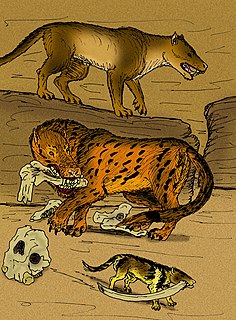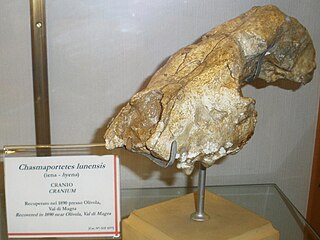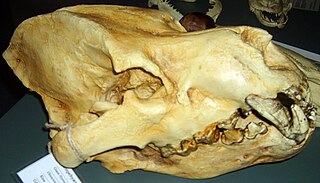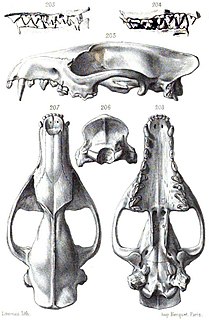
Hyenas, or hyaenas, are feliform carnivoran mammals of the family Hyaenidae. With only four extant species, it is the fifth-smallest family in the Carnivora and one of the smallest in the class Mammalia. Despite their low diversity, hyenas are unique and vital components of most African ecosystems.

Proteles is a genus of distinctive hyenas which contain the aardwolf (Proteles cristatus) and its close fossil relatives. It is the only genus of the subfamily Protelinae.

Megistotherium is an extinct genus of hyainailourid hyaenodonts from paraphyletic subfamily Hyainailourinae that lived in Africa.

Pachycrocuta is an extinct genus of prehistoric hyenas. The largest and most well-researched species is Pachycrocuta brevirostris, colloquially known as the giant short-faced hyena as it stood about 90–100 cm (35–39 in) at the shoulder and it is estimated to have averaged 110 kg (240 lb) in weight, approaching the size of a lioness, making it the largest known hyena. Pachycrocuta first appeared during the late Miocene. By 800,000 years ago, it became locally extinct in Europe and became completely extinct during the middle Pleistocene, 400,000 years ago.

Chasmaporthetes, also known as hunting or running hyena, is an extinct genus of hyenas distributed in Eurasia, North America, and Africa during the Pliocene-Pleistocene epochs, living from 4.9 million to 780,000 years ago, existing for about 4.12 million years. The genus probably arose from Eurasian Miocene hyenas such as Thalassictis or Lycyaena, with C. borissiaki being the oldest known representative. The species C. ossifragus was the only hyena to cross the Bering land bridge into the Americas, and ranged over what is now Arizona and Mexico during Blancan and early Irvingtonian Land Mammal ages, between 5.0 and 1.5 million years ago.

Percrocuta is an extinct genus of hyena-like feliform carnivores. It lived in Europe, Asia, and Africa, during the Miocene epoch.

Dissopsalis is a genus of teratodontine hyaenodonts of the tribe Dissopsalini. The older species, D. pyroclasticus, lived in Kenya during the middle Miocene, while the type species, D. carnifex, lived in Pakistan and India during the middle to late Miocene.

Percrocutidae is an extinct family of hyena-like feliform carnivores endemic to Asia, Africa, and Southern Europe from the Middle Miocene through the Pliocene, existing for about 8 million years.
Indohyaenodon is a genus of extinct hyaenodont mammals from family Indohyaenodontidae, that lived during the early Eocene in India.

Pliocrocuta is an extinct genus of terrestrial carnivore in the family Hyaenidae.

Cynohyaenodon is an extinct paraphyletic genus of hyaenodontid mammals from family Hyaenodontidae that lived during the early to middle Eocene in Europe.
Lahimia ("carnivore") is an extinct genus of hyaenodont mammals in family Boualitomidae, known from the Selandian stage of Morocco. Lahimia selloumi is the one of the oldest known members of order Hyaenodonta.

Teratodontidae is a family of extinct predatory mammals from extinct paraphyletic superfamily Hyainailouroidea within extinct order Hyaenodonta. Fossil remains of these mammals are known from Middle Eocene to Late Miocene deposits in Africa, the Arabian Peninsula, and Asia.

Metasinopa is a genus of teratodontine hyaenodont that lived during the early Oligocene in Egypt.

Hemipsalodon is an extinct genus of hyainailourid hyaenodonts from paraphyletic subfamily Hyainailourinae that lived in North America during the middle to late Eocene.
Ekweeconfractus is a genus of teratodontine hyaenodont known from 17 million year old deposits at the Moruorot site in Kenya.
Indohyaenodontidae is a family of extinct predatory mammals from extinct order Hyaenodonta. Fossil remains of these mammals are known from early to late Eocene deposits in Asia.

Hyainailouroidea ("hyena-cats") is a paraphyletic superfamily of extinct predatory mammals from extinct order Hyaenodonta. Fossil remains of these mammals are known from middle Eocene to late Miocene deposits in North America, Europe, Africa and Asia.

Dissopsalini is a extinct tribe of teratodontid hyaenodonts. Fossil remains of these mammals are known from early to late Miocene deposits in Asia and Africa.
Boualitomidae is a family of extinct predatory mammals from extinct order Hyaenodonta. Fossil remains of these mammals are known from middle Paleocene to late Eocene deposits in Africa. Boualitomids had only three pairs of premolars in the lower dentition, lacking the first one.











